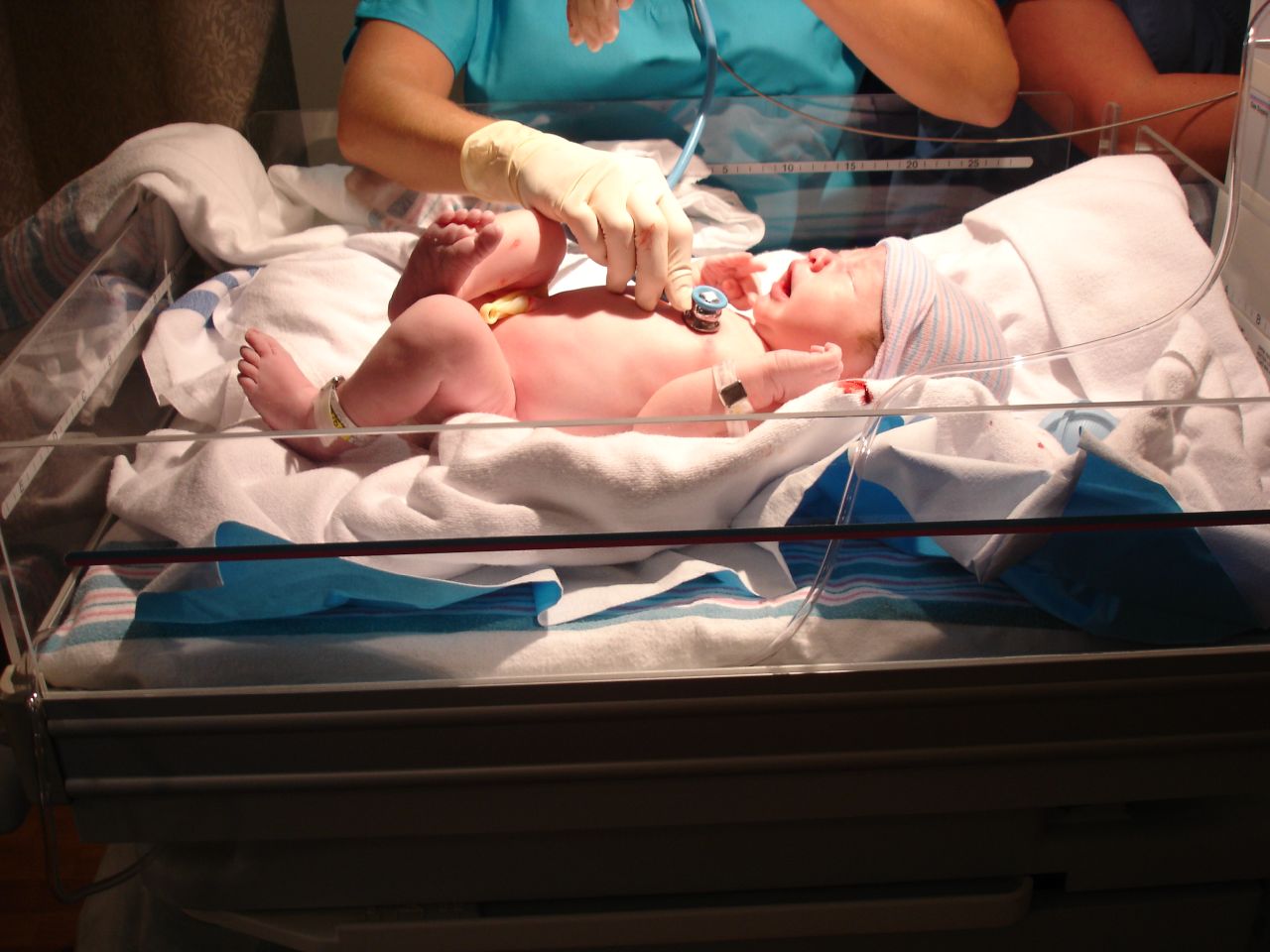Playlist
Show Playlist
Hide Playlist
Perinatal Infections
-
Slides PerinatalInfections Obstetrics.pdf
-
Download Lecture Overview
00:01 Now we will discussed perinatal infections. 00:05 So perinatal infections are better known as the TORCHeS. 00:08 That stands for Toxoplasmosis Others Rubella CMV Herpes and HIV and S stands for syphilis. 00:19 Let's talk about those in a little bit more detail. 00:23 So toxoplasmosis is transmitted to the fetus through the cat feces. 00:28 So this is one of the reasons that we tell pregnant moms, they should not deal with their kitty litter. 00:32 The O sites are passing to the kitty litter, and if mom comes in contact with that, she can contract toxoplasmosis that's can pass to the fetus to the placenta. 00:42 The diagnosis is made serologically. 00:46 And what affects it's going to have on the fetus. 00:48 Well the fetus can develop chorioretinitis and hydrocephalus. 00:51 But it is treatable. 00:53 We do give a medication. 00:55 We can either give pyrimethamine or we can give another name for that is Daraprim. 01:01 And we give sulphadiazine along with those medications. 01:07 So varicella also known as chicken pox. 01:10 Transmission is through respiratory droplets. 01:13 So if there is coughing or sneezing and mom comes in contact with that, she can develop varicella. 01:19 The diagnose is again made through blood work. 01:22 And the affects on the fetus where chorioretinitis is one. 01:26 Encephalitis is another one and muscle atrophy. 01:28 Unfortunately there is no treatment if mom contracts varicella during the pregnancy. 01:35 The risk of congenital varicella is highest if mom contracts chicken pox five days or less before delivery. 01:42 Or 1 to 2 days after delivery. 01:44 If a mom think she may have been exposed to varicella and it's not immune she can decrease the risk of congenital varicella by receiving VZIG, A recently approved Varicella Zoster immune globulin. 01:54 Although, best given within 96 hours of exposure, it's used is approved for up to 10 days to prevent or attenuate varicella infection. 02:01 Another infection that belongs to the others group is Hepatitis B. 02:05 It is transmitted parenteral and sexual. A diagnosis is possible via the HB Antigen Test (HBsAg). 02:10 Hepatitis B in the pregnancy can lead to chronic Hepatitis of the child. 02:14 For treatment, we can provide Hepatitis B immunoglobulin and vaccination of the neonate after delivery. 02:19 A cesarian delivery is only necessary if there are obstetric complications. 02:24 Breastfeeding is allowed. 02:26 Hepatitis C is another infection that influences the fetus. 02:29 Again, it is transmitted parenteral and sexual. 02:32 Screenings are not routinely recommended. 02:34 But when suspected, there is the HCV antibody test, followed by HCV nucleic acid testing. 02:40 Within Hepatitis C infection, there's an increased risk for progressing to chronic Hepatitis. 02:44 A cesarean delivery is only necessary if there are obstetric complications, and again breastfeeding is allowed. 02:50 A Group B Hemolytic Streptococcus infection is the last one on the other infections group. 02:56 It is transmitted through delivery after passing through a colonized genital tract. 03:00 It is routinely tested for with vaginal and rectal cultures at 35-37 weeks of gestation. 03:05 Possible effects on the fetus are pneumonia, sepsis, and meningitis. 03:09 As treatment, we can use intrapartum antibiotic prophylaxis with IV penicillin G. 03:15 So Rubella. 03:19 And this is a common appearance of rubella. 03:21 Transmission again is through cough or sneezing though those water droplets. 03:27 We diagnose this serologically as well. 03:29 And as far as the affects on the fetus, congenital hearing loss is one of the biggest ones. 03:35 It's actually one of the most common causes of hearing loss that comes from infection. 03:40 Also babies can develop cataracts or something called a Blueberry Muffin rash. 03:44 And that's what this looks like. 03:46 There is not treatment available during pregnancy. 03:51 This is one of the reasons in our preconceptional labs we screen to see if mom is in fact immune to rubella. 03:58 And if not we give her the vaccine so that she can develop immunity. 04:02 CMV. 04:04 Transmission is through body fluids, such as urine, saliva, blood, tears, semen and breast milk. 04:12 Now fortunately most moms have been exposed to CMV and so they do have immunity. 04:18 However, if you are concerned that the baby may have contracted CMV, the diagnose is made by PCR of amniotic fluid. 04:25 And what are the affects on the fetus. 04:27 Congenital hearing loss, vision loss or seizures. 04:31 Unfortunately there is no treatment available during pregnancy. 04:35 Now this is an example of genital herpes and what it looks like on physical exam. 04:41 Transmission for genital herpes is through sexual transmission via body fluids. 04:47 Again the diagnosis is made serologically. 04:50 And the affect on fetus is life threatening. 04:54 It could be death or they can have CNS abnormalities. 04:58 We do have treatment. 05:00 We give antivirals to moms who have history of genital herpes. 05:03 We administer those at 36 weeks of gestation. 05:07 We want to make sure that the mom is not having an outbreak at the time of delivery. 05:11 If she is, C-section is warranted, to try to prevent transmission to the fetus. 05:16 HIV, transmission is through body fluids. 05:20 And that can be through sexual contact. 05:23 It can be through blood. 05:24 Such as sharing IV needles. 05:26 Now diagnosis is made first by the ELISA test and then confirmed by the Western blot. 05:32 Now at birth, there is no affect on the fetus. 05:36 There are no signs to tell the baby has HIV. 05:38 And the treatment is HAART therapy. 05:41 So we do recommend that during the pregnancy so that mom can keep a low viral load. 05:46 If the viral load is less than a 1000, then the transmission rate is really low. 05:51 It's less than 1%. 05:53 If a mom has a viral load of less than a 1000, she can have a vaginal delivery without worry of transmitting HIV to the fetus. 06:00 However, if the viral load is greater than 1000, we would recommend C-section to again try to decrease that risk of transmission to the fetus. 06:08 This is an example of secondary syphilis. 06:14 Transmission of syphilis is through sexual contact. 06:18 Now let's talk a little bit about the diagnosis. 06:21 So all pregnant women should be screened for syphilis at the initial visit. 06:26 And then again in the 3rd trimester if they live in a high risk area. 06:30 Screening is via RPR or VDRL. 06:33 However, this is non-specific test. 06:35 And there are other things that can make this test positive such as lupus. 06:39 So the confirmation test should be performed, anybody has a positive screen. 06:44 That confirmation test is the antibody test that you can see here, listed here. 06:50 Of note, if a patient has ever been infected with syphilis they will always have positive antibodies. 06:55 In those cases you do have to look at your RPR to determine if they have a new infection based on the titer rate. 07:03 The other way that you can confirm, syphilis is looking for treponemes on dark-field microscopy. 07:09 So with syphilis, what are the affects on the fetus? Hepatomegaly meaning a large liver. 07:15 CNS abnormalities, saddle nose and Hutchinson's teeth. 07:19 The Hutchinson's teeth is pretty diagnostic of syphilis. 07:23 So the treatment is penicillin. 07:26 Even if a patient is allergic, we still give penicillin as a treatment only in pregnancy. 07:32 If a patient is penicillin allergic, they're first desensitize to make the reaction a little bit less severe. 07:39 And then give him penicillin to make sure that they can have their syphilis treated.
About the Lecture
The lecture Perinatal Infections by Veronica Gillispie, MD, MAS, FACOG is from the course Antenatal Care. It contains the following chapters:
- Perinatal Infections
- Toxoplasmosis
- Rubella
- CMV
- HIV
- Syphilis
Included Quiz Questions
Which of the following should pregnant women avoid to reduce the risk of toxoplasmosis transmission to a fetus through the placenta?
- Contact with cat feces
- Needle sharing
- Unprotected intercourse
- Children with chicken pox
- People non-immune to rubella
How should a pregnant woman be treated if she is exposed to toxoplasmosis?
- Pyrimethamine and sulfadiazine
- Penicillin
- Penicillin after sensitization to the antibiotic
- There is no treatment for toxoplasmosis during pregnancy.
- Sulfadiazine
Which of the following negative fetal outcomes can occur if a woman contracts the varicella virus during pregnancy?
- Chorioretinitis
- Hearing loss
- Hepatomegaly
- "Blueberry muffin" rash
How is the rubella virus typically transmitted to pregnant women?
- Respiratory particles
- Skin contact
- Sexually transmitted
- Animal feces
- Unwashed fruits and vegetables
How is a rubella virus infection treated during pregnancy?
- There is no treatment for rubella virus infection during pregnancy.
- Penicillin
- Sensitization with penicillin, then penicillin treatment
- Antiviral
- Pyrimethamine
How is cytomegalovirus (CMV) transmitted?
- Body fluids
- Skin contact
- Coughing/sneezing
- Animal feces
- Uncooked meats
If there is concern for contraction of cytomegalovirus (CMV) during pregnancy, how is it diagnosed?
- Amniotic fluid test
- Maternal blood test
- Fetal blood test
- There is no test for CMV.
- Dark field microscopy
What is a potential effect of cytomegalovirus (CMV) infection in a fetus?
- Seizures
- Cataracts
- Muscle atrophy
- Macrocephaly
- Cleft palate
A 30-year-old G3P0 woman has a history of genital herpes. She does not have any current lesions. What is the optimal treatment plan?
- Start antiviral therapy at 36 weeks gestation, and delivery by cesarean section if she has any lesions at the time of delivery
- Start antiviral therapy from the first trimester to continue throughout pregnancy until normal vaginal delivery
- Start antiviral therapy only if she has any active herpes lesions
- Deliver via cesarean section no matter if lesions are visible or not
- Start antiviral therapy at 24 weeks gestation, and deliver by cesarean section if she has any lesions at the time of delivery
At what viral load can a woman with HIV deliver via vaginal delivery with a low risk of transmission of the virus to the baby?
- Viral load less than 1,000
- Viral load less than 10,000
- Undetectable viral load
- Women who have HIV should only deliver via cesarean section no matter the viral load.
- Viral load less than 100,000
Hutchinson's teeth are pathognomonic for which congenital infectious disease?
- Syphilis
- Herpes
- HIV
- Toxoplasmosis
- Rubella
Customer reviews
5,0 of 5 stars
| 5 Stars |
|
5 |
| 4 Stars |
|
0 |
| 3 Stars |
|
0 |
| 2 Stars |
|
0 |
| 1 Star |
|
0 |




